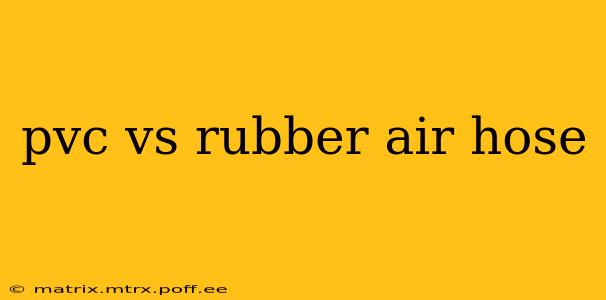Choosing the right air hose can significantly impact the efficiency and longevity of your pneumatic tools and systems. Two popular choices are PVC and rubber air hoses, each with its own set of advantages and disadvantages. This comprehensive guide will delve into the key differences between PVC and rubber air hoses, helping you make an informed decision based on your specific application.
What are the main differences between PVC and rubber air hoses?
The primary differences between PVC and rubber air hoses lie in their material composition, resulting in variations in flexibility, durability, temperature resistance, and cost. PVC (polyvinyl chloride) hoses are generally lighter, more flexible, and less expensive than rubber hoses. Rubber hoses, on the other hand, tend to be more durable and resistant to abrasions, chemicals, and extreme temperatures.
What are the advantages of PVC air hoses?
- Lightweight and Flexible: PVC hoses are significantly lighter and more flexible than rubber hoses, making them easier to maneuver and handle, especially in tight spaces. This ease of use is a major advantage for many applications.
- Cost-Effective: PVC hoses are generally less expensive than rubber hoses, making them a budget-friendly option for less demanding applications.
- Good for Indoor Use: In controlled indoor environments, PVC hoses often suffice.
What are the disadvantages of PVC air hoses?
- Lower Durability: PVC hoses are less resistant to abrasion, punctures, and UV degradation compared to rubber hoses. They are more susceptible to damage from rough handling or exposure to sunlight.
- Limited Temperature Range: PVC hoses have a more limited operating temperature range than rubber hoses, making them unsuitable for extreme hot or cold environments.
- Less Chemical Resistance: PVC is less resistant to certain chemicals and oils compared to some rubber compounds.
What are the advantages of rubber air hoses?
- Superior Durability: Rubber hoses are known for their exceptional durability and resistance to abrasion, punctures, and kinks. They can withstand harsher conditions and rough handling.
- Wider Temperature Range: Rubber hoses generally have a much wider operating temperature range, making them suitable for use in various environments.
- Better Chemical Resistance: Many rubber compounds offer superior resistance to chemicals, oils, and fuels compared to PVC.
- Longer Lifespan: Due to their enhanced durability, rubber hoses typically have a longer lifespan than PVC hoses.
What are the disadvantages of rubber air hoses?
- Heavier and Less Flexible: Rubber hoses are heavier and less flexible than PVC hoses, making them more cumbersome to handle, especially in confined spaces.
- Higher Cost: Rubber hoses are typically more expensive than PVC hoses.
- Potential for Degradation: While durable, rubber hoses can still degrade over time, especially with prolonged exposure to sunlight, ozone, or certain chemicals.
Which type of air hose is best for my needs?
The best type of air hose for your needs depends on several factors, including the application, the environment, and your budget.
-
For light-duty, indoor applications where flexibility and cost are primary concerns, a PVC hose is often a suitable choice. Examples include hobbyist projects or light-duty tasks in a controlled environment.
-
For heavy-duty applications, outdoor use, or exposure to harsh conditions, a rubber hose is generally recommended. This includes construction sites, industrial settings, or applications involving chemicals or extreme temperatures.
-
Consider the pressure requirements: Always check the working pressure rating of the hose to ensure it can handle the pressure of your air compressor and tools. Both PVC and rubber hoses are available in various pressure ratings.
How do I maintain my air hose?
Proper maintenance can extend the lifespan of both PVC and rubber air hoses. This includes:
- Regular Inspection: Check for cracks, cuts, or abrasions regularly.
- Proper Storage: Store hoses in a cool, dry place, away from direct sunlight and harsh chemicals.
- Avoid Overbending: Avoid repeatedly bending the hose sharply, as this can weaken it.
- Clean Regularly: Remove any dirt or debris from the hose.
By carefully considering the advantages and disadvantages of each type of hose and your specific application requirements, you can choose the ideal air hose for your needs and ensure the longevity and effectiveness of your pneumatic tools and systems.
